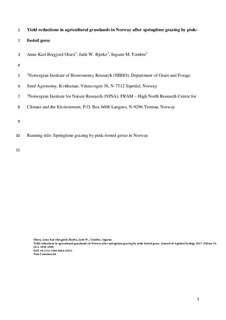| dc.contributor.author | Olsen, Anne Kari Bergjord | |
| dc.contributor.author | Bjerke, Jarle W. | |
| dc.contributor.author | Tombre, Ingunn | |
| dc.coverage.spatial | Norway | nb_NO |
| dc.date.accessioned | 2018-03-23T09:45:55Z | |
| dc.date.available | 2018-03-23T09:45:55Z | |
| dc.date.created | 2017-12-25T14:59:44Z | |
| dc.date.issued | 2017 | |
| dc.identifier.citation | Journal of Applied Ecology. 2017, 54 (6), 1836-1846. | nb_NO |
| dc.identifier.issn | 0021-8901 | |
| dc.identifier.uri | http://hdl.handle.net/11250/2491849 | |
| dc.description.abstract | 1.A large population increase of the Svalbard-breeding pink-footed goose Anser brachyrhynchus over recent decades has intensified the conflict with agriculture at the spring-staging sites in Norway. Knowledge of the yield loss caused by goose grazing in these northern areas is lacking, and the motivation behind the study was to quantify a relationship between grazing pressure and yield loss of agricultural grasslands and corresponding changes in vegetation composition. 2.Field trials were established on agricultural grasslands at four sites in central Norway. Eight plots were established at each site; four with exclosures to exclude or reduce grazing from geese and four with access for the geese. The exact same plots were followed for 2–4 years. Dropping density, used as a measure of grazing pressure, and compressed sward height were recorded throughout the goose staging periods, and dry matter yield was determined at first and second harvests. Plant samples from first harvests were analysed for vegetation composition. 3.Grazing pressure varied between both years and sites. Exclosures reduced grazing pressure by 75–78% during high-pressure grazing periods and increased first harvest yields by up to 31%. At lower grazing pressure, exclosures prevented grazing completely. Grazing pressure was inversely correlated with dry matter yield at first harvest, but second harvest yields were unaffected. 4.The fraction of sown species declined while the fraction of weeds increased during the study both in open plots and exclosures, but level of grazing pressure did not have any significant influence on the overall fraction of sown species, or in any specific year. 5.Synthesis and applications. As the same plots were measured over several years, it was possible to quantify goose-grazing effects beyond one season. In the context of the wildlife-agriculture conflict, the results demonstrate that some farmers always suffer disproportionately with yearly variations. The relationship between grazing pressure and yield loss may provide knowledge to a regional goose grazing subsidy scheme in the study area, identifying the most affected areas and distributing the subsidies correspondingly. However, the seasonal variations in grazing pressure demonstrate the difficulty of targeting exact areas on a yearly basis. On the other hand, the observed variations may promote another management tool in the form of delayed ploughing of stubble fields before spring sowing, as stubble fields may attract more geese, reducing the grazing pressure on agricultural grasslands and hence the overall conflicts with agricultural interests. | nb_NO |
| dc.language.iso | eng | nb_NO |
| dc.title | Yield reductions in agricultural grasslands in Norway after springtime grazing by pink-footed geese | nb_NO |
| dc.type | Journal article | nb_NO |
| dc.type | Peer reviewed | nb_NO |
| dc.description.version | acceptedVersion | nb_NO |
| dc.subject.nsi | VDP::Matematikk og Naturvitenskap: 400::Zoologiske og botaniske fag: 480 | nb_NO |
| dc.source.pagenumber | 1836-1846 | nb_NO |
| dc.source.volume | 54 | nb_NO |
| dc.source.journal | Journal of Applied Ecology | nb_NO |
| dc.source.issue | 6 | nb_NO |
| dc.identifier.doi | 10.1111/1365-2664.12914 | |
| dc.identifier.cristin | 1531923 | |
| dc.relation.project | Norges forskningsråd: 204342 | nb_NO |
| cristin.unitcode | 7511,4,0,0 | |
| cristin.unitname | Tromsø | |
| cristin.ispublished | true | |
| cristin.fulltext | postprint | |
| cristin.qualitycode | 2 | |
